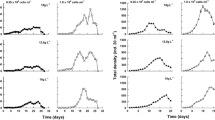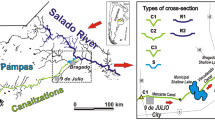Abstract
Densities ofAeromonas hydrophila were determined monthly from December 1975 to December 1977 in a South Carolina cooling reservoir which receives heated effluent from a single nuclear production reactor. Selected water quality parameters and prevalence of red-sore disease among largemouth bass were monitored simultaneously.
Higher densities ofA. hydrophila were observed in areas of the reservoir receiving effluent from the reactor. Densities ofA. hydrophila generally were heterogeneous in the water column. The sediments had lower densities ofA. hydrophila than water immediately above.A. hydrophila could not be isolated from sediments greater than 1 cm from the water interface. Temperature, redox potential, pH, and conductivity were all significantly correlated with densities ofA. hydrophila in the water column. The temporal and spatial distribution and abundance ofA. hydrophila in water were not related to total organic carbon, dissolved organic carbon, particulate organic carbon, inorganic carbon, or dissolved oxygen. High densities ofA. hydrophila were observed in mats of decomposingMyriophyllum spicatum and, enterically, in largemouth bass, several other species of fish, turtles, alligators, and snails. The greatest densities ofA. hydrophila in water occurred during March and June with a second peak in October. The mean monthly densities ofA. hydrophila were positively correlated with the incidence of infection in largemouth bass. Largemouth bass from thermally altered parts of the reservoir had a significantly higher incidence of infection. It is concluded that thermal effluent significantly affects the ecology ofA. hydrophila and the epizootiology of red-sore disease within Par Pond.
Similar content being viewed by others
References
Christy, E. J., J. O. Farlow, J. E. Bourque, and J. W. Gibbons: Enhanced growth and increased body size of turtles living in thermal and post-thermal systems. In J. W. Gibbons and R. R. Sharitz (eds.): Thermal Ecology, pp. 277–284. AEC Symposium Series (CONF-730505) (1974)
Davies, R. G.: Computer Programming in Quantitative Biology. Academic Press, New York (1971)
Davis, W. A., J. G. Kane, and V. G. Garaguis: HumanAeromonas infections: a review of the literature and a case report of endocarditis. Medicine (Baltimore)57, 267–277 (1978)
Emerson, H. and C. Nonrris: “Red Leg”-an infectious disease of frogs. J. Exp. Med.7, 32–60 (1905)
Esch, G. W., and T. C. Hazen: Thermal ecology and stress: a case history for red-sore disease in largemouth bass (Micropterus salmoides). In: J. H. Thorpe and J. W. Gibbons (eds.): Energy and Environmental Stress in Aquatic Systems, pp. 331–363. DOE Symposium Series (CONF-771114) (1978)
Esch, G. W., T. C. Hazen, R. V. Dimock, Jr., and J. W. Gibbons: Thermal effluent and the epizootiology of the ciliateEpistylis and the bacteriumAeromonas in association with centrarchid fish. Trans. Am. Microsc. Soc.95, 687–693 (1976)
Fliermans, C. B., R. W. Gorden, T. C. Hazen, and G. W. Esch:Aeromonas distribution and survival in a thermally altered lake. Appl. Environ. Microbiol.33, 114–122 (1977)
Fulghum, D. D., W. R. Linton, Jr., and D. Taplin: FatalAeromonas hydrophila infection of the skin. South. Med. J.71, 733–741 (1978)
Gibbons, J. W., and R. R. Sharitz: Thermal alteration of aquatic ecosystems. Am. Sci.62, 660–670 (1974)
Gibson, D. M., M. S. Hendrie, N. C. Houston, and G. Hobbs: The identification of some gram negative heterotrophic aquatic bacteria. In F. A. Skinner and J. M. Shewan (eds.): Aquatic Microbiology, pp. 135–159. Academic Press, New York (1977)
Giesy, J. P., and D. Paine: Uptake of americium-241 by algae and bacteria. Appl. Environ. Microbiol.33, 89–96 (1977)
Grace, J. B., and L. J. Tilly: Distribution and abundance of submerged macrophytes, includingMyriophyllum spicatum L. (Angiospermae), in a reactor cooling reservoir. Arch. Hydrobiol.4, 473–480 (1976)
Haley, R., S. P. Davis, and J. M. Hyde: Environmental stress andAeromonas liquefaciens in American and threadfin shad mortalities. Prog. Fish-Cult.29, 193 (1967)
Hanson, P. G., J. Standridge, F. Jarret, and D. G. Maki: Freshwater wound infection due toAeromonas hydrophila. J. A. M. A.238, 1053–1054 (1977)
Hazen, T. C.: The ecology ofAeromonas hydrophila in a South Carolina cooling reservoir. Ph.D. thesis, Wake Forest University, Winston-Salem, N.C. (1978)
Hazen, T. C., G. W. Esch, A. B. Glassman, and J. W. Gibbons: Relationship of season, thermal loading and red-sore disease with various hematological parameters inMicropterus salmoides. J. Fish Biol.12, 491–498 (1978)
Hazen, T. C., and C. B. Fliermans: The distribution ofAeromonas hydrophila in natural and man-made thermal effluents. Appl. Environ. Microbiol.38, 166–168 (1979)
Hazen, T. C., C. B. Fliermans, R. P. Hirsch, and G. W. Esch: The prevalence and distribution ofAeromonas hydrophila in the United States. Appl. Environ. Microbiol.36, 731–738 (1978)
Hazen, T. C., M. L. Raker, G. W. Esch, and C. B. Fliermans: Ultrastructure of red-sore lesions on largemouth bass (Micropterus salmoides): the association of the peritrichEpistylis sp. and the bacteriumAeromonas hydrophila. J. Protozool.25, 351–355 (1978)
Kuznetsov, S. E.: The Microflora of Lakes and Its Geochemical Activity. University of Texas Press, Austin (1970)
Kuznetsov, S. I., and V. I. Romanenko: Microbiological characteristics of the Tsimlyansk reservoir. In: Sbornik: Mikroflora, fitoplankton: vysshie rasteuiya unutreunikh vodoemove; Trudy Instituto Biologii Unutreunikh15, 3–6 (1967)
Lewis, W. M.: Evaluation of heat distribution in a South Carolina reservoir receiving heated water. In J. W. Gibbons and R. R. Sharitz (eds): Thermal Ecology, pp. 1–27. AEC Symposium Series (CONF-730505)
Marcus, L. C.: Infectious diseases of reptiles. Am. Vet. Med. Assoc.159, 1626–1631 (1971)
Mead, A. R.:Aeromonas liquefaciens in the leukodemia syndrome ofAchatina fulica. Malacologia9, 43 (1969)
Miller, R. M., and W. R. Chapman: Epistylis andAeromonas hydrophila infections in fishes from North Carolina reservoirs. Prog. Fish-Cult.38, 165–168 (1976)
Neill, J. S., and D. F. Babcock: The dissipation of reactor heat at the Savannah River Plant. USDOE Document (DP-1247), Savannah River Laboratory, E. I. DuPont de Nemours (1971)
Parker, E. D., M. F. Hirshfield, and J. W. Gibbons: Ecological comparisons of thermally affected aquatic environments. J. Water Pollut. Control Fed.45, 726–733 (1973)
Rand, M. C.: Standard Methods for the Examination of Water and Wastewater. American Public Health Association, Washington, D.C. (1975)
Rogers, W. A.: Disease in fish due to the protozoanEpistylis (ciliata: peritricha) in the south-eastern U.S. Proc. 25th Conf. S. E. Assoc. Game and Fish Comm., pp. 493–496 (1971)
Ross, A. J., and C. A. Smith: Effect of temperature on survival ofAeromonas liquefaciens, Aeromonas salmonicida, Chondrococcus columnaris andPseudomonas fluoresens. Prog. Fish-Cult.36, 51–52 (1974)
Rouf, M. A., and M. M. Rigney: Growth temperatures and temperature characteristics ofAeromonas. Appl. Microbiol.22, 503–506 (1971)
Sharitz, R. R., J. W. Gibbons, and S. C. Gause: Impact of production reactor effluents on vegeation in a southeastern swamp forest. In J. W. Gibbons and R. R. Sharitz (eds): Thermal Ecology, pp. 356–362. AEC Symposium Series (CONF-730505) (1974)
Shotts, E. B., Jr., J. L. Gaines, C. Martin, and A. K. Prestwood:Aeromonas-induced deaths among fish and reptiles in an eutrophic inland lake. J. Am. Vet. Med. Assoc.161, 603–607 (1972)
Shotts, E. B., Jr., and R. Rimler: Medium for the isolation ofAeromonas hydrophila. Appl. Microbiol.26, 550–553 (1973)
Snieszko, S. F.: The effects of environmental stress on outbreaks of infectious disease of fish. J. Fish Biol.6, 197–208 (1974)
Thorpe, J. E., and R. J. Roberts: An aeromonad epidemic in the brown trout. J. Fish Biol.4, 441–451 (1972)
Tilly, L. J.: Comparative productivity of four Carolina lakes. Am. Midland Naturalist90, 356–365 (1973)
Tilly, L. J.: Changes in water chemistry and primary productivity of a reactor cooling reservoir (Par Pond). In F. G. Howell, J. B. Gentry, and M. H. Smith (eds.): Mineral Cycling in South-eastern Ecosystems. ERDA Symposium Series (CONF-740513) (1975)
Vezina, R., and R. Desrochers: Incidence d'Aeromonas hydrophila chez la perche,Perca flavescens. Can. J. Microbiol.17, 1101–1103 (1971)
Vigerstad, T. J., and L. J. Tilly: Hyperthermal effluent effects on heleoplankton cladocera and the influence of submerged macrophytes. Hydrobiologia55, 81–85 (1977)
Wohlegemuth, K., R. L. Pierce, and C. A. Kirkbride: Bovine abortion associated withAeromonas hydrophila. J. Am. Vet. Med. Assoc.160, 1001 (1972)
Wright, R. T., and J. E. Hobbie: The uptake of organic solutes in lake water. Limnol. Oceangr.10, 22–28 (1965)
Zar, J. H.: Biostatistical Analysis. Prentice-Hall, Englewood Cliffs, N.J. (1974)
Author information
Authors and Affiliations
Rights and permissions
About this article
Cite this article
Hazen, T.C. Ecology ofAeromonas hydrophila in a South Carolina cooling reservoir. Microb Ecol 5, 179–195 (1979). https://doi.org/10.1007/BF02013525
Issue Date:
DOI: https://doi.org/10.1007/BF02013525




